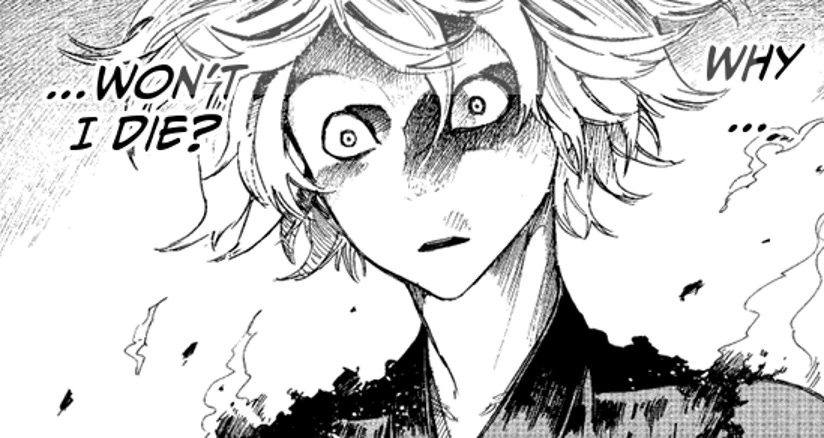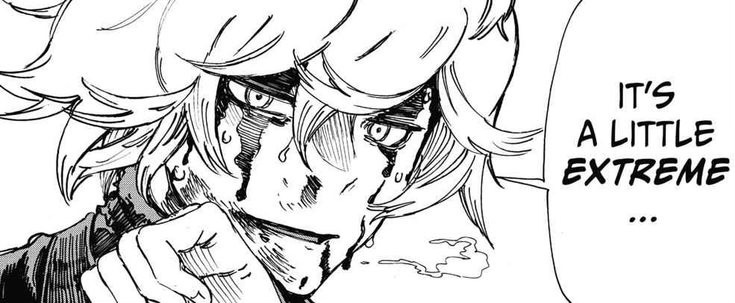Preface!
We all look for ourselves in characters, right? I’m not projecting that on other people? It’s what I do. I look for characters I associate with, namely in their motivation. In manga, that’s not always easy to find. Luffy wants to be the pirate king. Sure, I do too, but that’s not really a tangible “yeah, I feel that” kinda vibe.
Hell’s Paradise is the first manga where I’ve had a protagonist I immediately vibed with. Gabimaru just wants to get back to his wife, whom he loves. What a wonderfully down to earth objective for a plot that spirals into an unforgivingly brutal narrative.
But that’s what made me stick with Hell’s Paradise long enough to realize how much I loved it. Which, by the way, is a whole lot.
Preface over.
There’s this bit of writing knowledge I’ve used so much over the years that I forget where it even came from. It goes, quite simply: “every sentence’s job is to get the reader to read the next sentence.” To translate that to manga, “every panel’s job is to get the reader to the next panel.” And it grows from there, “every chapter’s job is to get the reader to the next chapter.” So on and so forth.
The point is, you need a good hook to keep the reader engaged. At all times. Without a hook, why are readers coming back? Especially at the beginning. Once you get deeper into the series, the need for a hook alleviates a bit. Readers are engaged, they care about the characters, they’re willing to grant you some leeway while they wait for that next hook. They’re willing to see all their favorite heroes sit around and celebrate Christmas, because they love the characters so much that every day life is entertaining.
But at the start of the story, you need a hook. Which is a simplified way of saying you need narrative tension. The thing is, narrative tension can come from literally anywhere. Which makes it both such a useful creative tool, but also an intimidating one.
Every element of the story can lead to tension. Luke Skywalker’s family situation springs up—tension. Saruman has gone bad—tension. And, if done right, until that tension is resolved, the reader/viewer is engaged. They want to see the resolution.
Obligatory (and overly simplified) synopsis of Hell’s Paradise, in case you haven’t read it. Gabimaru, our protagonist ninja, is to be executed, but he and a bunch of criminals are given the chance at a pardon if they go to this deadly island to find the elixir of life. But only one criminal can get the pardon. Each criminal is paired with an executioner, who is ordered to kill their assigned criminal if they disobey.
That’s all you need to know.
What Hell’s Paradise does is it makes the narrative tension so diverse and multifaceted that it’s a knot of perpetual danger you can’t look away from. And that danger is coming from different sources. It’s not just all loaded into the setting, this dangerous island with deadly creatures. It’s not all plot, this deadly competition that only one can win. And it’s not all character, these deadly criminals and executioners who can kill another human being in a single moment. And it’s not all character growth, these inward searches for identity and purpose.
It’s all of those things, and more. Within the first ten chapters, here are all the points of tension:
Anyone could die at any moment from the island itself (setting)
Anyone could die at any moment by being killed by someone else (character)
Only one person can succeed in this quest (plot)
People do die, we see it happen, and often (character)
Gabimaru wants to get back to his wife (character/plot)
Gabimaru wife is in danger back home (plot)
There’s a faction of “bad guys” defending this island (plot/character/setting)
Gabimaru’s executioner is having her own internal issues (character)
So is Gabimaru (character)
So is pretty much every other character (character)
And there will probably be more, I’m not all the way through yet.
Think about Star Wars for a second, the sources of tension. Luke and his daddy situation (character), the Empire is a constant threat (plot), the Rebels have to stay hidden (plot). But even when you start adding in new things, like Obi-Wan and Vader (character) or the cold of Hoth (setting), those things get resolved.
Same goes with Lord of the Rings. There is the big tension, destroy the ring (plot). But there are side bits of tension that spring up along the way too: defend Helm’s Deep (plot/setting), Aragorn’s destiny (character), Gollum’s treachery (character), Shelob’s lair (plot/setting).
So much tension, so much to play with. But they aren’t all striking at once.
It absolutely is in Hell’s Paradise, which keeps the tension cranked up to 11, with the occasional minor resolution. Hell’s Paradise does not resolve tension quickly. All of those points of tension essentially worsen as we learn more and go further into this island.
Thinking of other “high danger” manga, there’s more than a few, but they all have their bits of reprieve. In Black Clover, there’s always time to regroup and hang out in safety. In Jujutsu Kaisen, even when the showdown with Sukuna is happening (as of writing, it actively is), there’s a group of good guys sitting around in safety. In One Piece, it’s common for different characters to have different stakes at all times, but nothing to scale with Hell’s Paradise.
The key is the setting. In Hell’s Paradise, the setting sets a baseline for tension that’s hard to find elsewhere. With such a deadly world, every other bit of tension is magnified. Every other manga example I’ve given, and many more, takes place in an otherwise ordinary world that, for the most part, isn’t actively trying to kill its inhabitants.
But Hell’s Paradise could have stopped there. What if all the criminals and executioners teamed up to take on this world together? The tension would be significantly lessened. They took care of that with two crucial elements: only one can win, and these are some pretty volatile humans capable of extreme evil.
We all know how much manga loves competitions. Whether it’s friendly competition in My Hero Academia or deadly competition in Jujutsu Kaisen, pitting characters against each other is nothing extraordinary. But again, Hell’s Paradise didn’t stop there. Their competition is steeped in unavoidable death and populated by the extremely deadly.
And let me say this again—people die. Often. There is no plot armor here. Which helps that tension feel even more tangible.
The logical follow-up is, well, is that too much tension?
And the answer is a hearty no. Because amidst this spiral of tension and deadliness and horror is a meaningful pursuit of humanity and common ground among a handful of characters. Namely, Gabimaru’s desire to get home to his wife. See, you thought I wouldn’t come back to that, but it comes full circle. In most manga, the primary objective is something larger than life—be the best ____ in the world. Gabimaru just wants to get home to his wife. The tension ripples out from that, but the foundational objective is clear and simple, and the goodness of each character, where once there was primarily coldness and evil, begins to emerge. So we still get traditional and satisfying character arcs to root for.
This isn’t the last I’ve written about Hell’s Paradise. It’s the best hook of narrative tension I’ve seen in manga yet, and it will always be the benchmark for how to keep tension high.
For creative writers: Where is your story’s tension coming from? Where else can it come from?
For fans of Hell’s Paradise: What manga compare on a danger level, and also, why do I love Aza so much?






